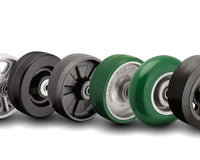Our caster basics series has reviewed almost all of the elements of a caster from the (literal) ground up from wheels to rigs. Now it’s time to cover another critical part of a caster: the mount. The mount type is usually dictated by the item the caster is attached to, and there are many options available. Learn more about them below.
Grip Ring Stems
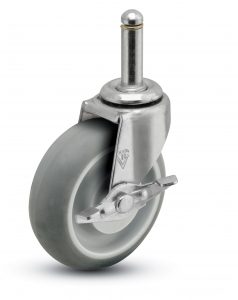
Grip ring stems are quite possibly the most common caster stem in use. Used predominantly in consumer and commercial office and shop equipment, this stem provides rapid installation and quick change. Grip ring stems are typically available on furniture and institutional casters, and are most commonly used on molded plastic components wherein the socket can be made an integral part of the equipment. Due to this design element, grip ring stem casters usually offer lower overall weight capacity.
The stem works by utilizing a piece of round steel with a channel machined in the top portion. The machined channel is then fitted with a locking ring, either brass or steel. The mounting sockets are made to match the stem, with a recessed race in the top portion of the socket, so as to accept the locking ring from the stem. When inserted the locking ring expands into the recessed race, locking the stem into position. The mechanism provides positive retention, without impeding removal should it be required.
Threaded Stems
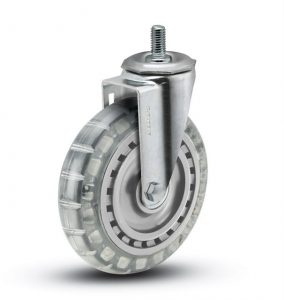
A threaded stem is quite simple - it’s a round piece of metal with a cut thread, similar to a bolt. Because threaded stems come in nearly any size, metric or standard, small to large diameter, fine or coarse thread, the options are many. Threaded stems are available standard on institutional and furniture casters, and through special order on industrial casters.
A threaded stem provides a more secure mounting than any other stem mount. Where grip ring and grip neck stems can become loose over time, the threaded stem, short of the stem shearing, will remain in place. A fair comparison between grip and threaded stems is nails to screws.
In order for a threaded stem caster to be attached to equipment, the equipment must have a tapped bore to accept the stem.
Grip Neck
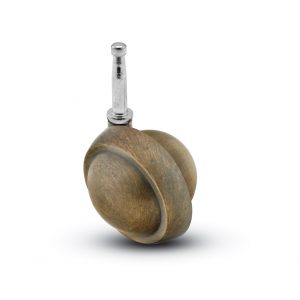
A grip neck or wood stem, as the name implies, is ideal for equipment made of wood. They are found only on furniture and institutional casters.A grip neck stem uses a flanged top to capture the stem in the pre-manufactured socket. Though most commonly used on wood furniture, they are used on certain plastic and metal equipment.
Unlike a grip-ring stem, grip neck stems are available in one size, 5/16″ diameter x 1-1/2″ long. Given that, they are the easiest to find replacements for should they break. However, they are incredibly hard to remove from the socket once installed.
Expanding Adapters
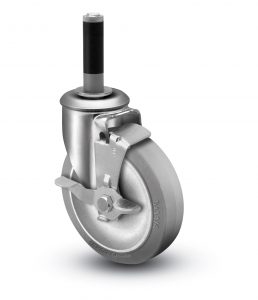
Expanding adapters are a hybrid design, utilizing a threaded stem with a flexible socket adapter. Typically they are constructed with 4 parts: a threaded stem, a compression nut, a rubber expansion ring, and a plastic washer. In essence, they are a hybrid of a grip ring and threaded stem.
Because the rubber insert can dry-rot, these stems should not be used in wash-down or autoclave applications. Once the rubber has dried out the caster may, for lack of a better phrase, fall out of the equipment.
These stems are usually used on equipment where a standard socket is not available because of the inside diameter of the round tube or pipe. They are installed by inserting the stem into the pipe and then turning the nut on the bottom side of the swivel section to tighten into place.
Round Stem
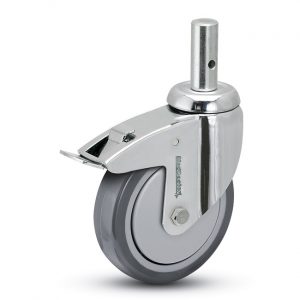
Round stems are by far the simplest stem design around. It is literally a piece of round stock riveted into the kingpin of the caster. Instead of using a locking ring to hold it in place like a grip ring, it is a simple compression fit.
Round stem casters are very rare. Normally a grip ring or threaded stem is used due to their locking ability. We do not recommend using a round stem, if at all possible.
Top Plate
Our caster basics series has reviewed almost all of the elements of a caster from the (literal) ground up from wheels to rigs. Now it’s time to cover another critical part of a caster: the mount. The mount type is usually dictated by the item the caster is attached to, and there are many options available. Learn more about them below.
Grip Ring Stems
 Grip ring stems are quite possibly the most common caster stem in use. Used predominantly in consumer and commercial office and shop equipment, this stem provides rapid installation and quick change. Grip ring stems are typically available on furniture and institutional casters, and are most commonly used on molded plastic components wherein the socket can be made an integral part of the equipment. Due to this design element, grip ring stem casters usually offer lower overall weight capacity.
Grip ring stems are quite possibly the most common caster stem in use. Used predominantly in consumer and commercial office and shop equipment, this stem provides rapid installation and quick change. Grip ring stems are typically available on furniture and institutional casters, and are most commonly used on molded plastic components wherein the socket can be made an integral part of the equipment. Due to this design element, grip ring stem casters usually offer lower overall weight capacity.
The stem works by utilizing a piece of round steel with a channel machined in the top portion. The machined channel is then fitted with a locking ring, either brass or steel. The mounting sockets are made to match the stem, with a recessed race in the top portion of the socket, so as to accept the locking ring from the stem. When inserted the locking ring expands into the recessed race, locking the stem into position. The mechanism provides positive retention, without impeding removal should it be required.
Threaded Stems
 A threaded stem is quite simple - it’s a round piece of metal with a cut thread, similar to a bolt. Because threaded stems come in nearly any size, metric or standard, small to large diameter, fine or coarse thread, the options are many. Threaded stems are available standard on institutional and furniture casters, and through special order on industrial casters.
A threaded stem is quite simple - it’s a round piece of metal with a cut thread, similar to a bolt. Because threaded stems come in nearly any size, metric or standard, small to large diameter, fine or coarse thread, the options are many. Threaded stems are available standard on institutional and furniture casters, and through special order on industrial casters.
A threaded stem provides a more secure mounting than any other stem mount. Where grip ring and grip neck stems can become loose over time, the threaded stem, short of the stem shearing, will remain in place. A fair comparison between grip and threaded stems is nails to screws.
In order for a threaded stem caster to be attached to equipment, the equipment must have a tapped bore to accept the stem.
Grip Neck
 A grip neck or wood stem, as the name implies, is ideal for equipment made of wood. They are found only on furniture and institutional casters.A grip neck stem uses a flanged top to capture the stem in the pre-manufactured socket. Though most commonly used on wood furniture, they are used on certain plastic and metal equipment.
A grip neck or wood stem, as the name implies, is ideal for equipment made of wood. They are found only on furniture and institutional casters.A grip neck stem uses a flanged top to capture the stem in the pre-manufactured socket. Though most commonly used on wood furniture, they are used on certain plastic and metal equipment.
Unlike a grip-ring stem, grip neck stems are available in one size, 5/16″ diameter x 1-1/2″ long. Given that, they are the easiest to find replacements for should they break. However, they are incredibly hard to remove from the socket once installed.
Expanding Adapters
 Expanding adapters are a hybrid design, utilizing a threaded stem with a flexible socket adapter. Typically they are constructed with 4 parts: a threaded stem, a compression nut, a rubber expansion ring, and a plastic washer. In essence, they are a hybrid of a grip ring and threaded stem.
Expanding adapters are a hybrid design, utilizing a threaded stem with a flexible socket adapter. Typically they are constructed with 4 parts: a threaded stem, a compression nut, a rubber expansion ring, and a plastic washer. In essence, they are a hybrid of a grip ring and threaded stem.
Because the rubber insert can dry-rot, these stems should not be used in wash-down or autoclave applications. Once the rubber has dried out the caster may, for lack of a better phrase, fall out of the equipment.
These stems are usually used on equipment where a standard socket is not available because of the inside diameter of the round tube or pipe. They are installed by inserting the stem into the pipe and then turning the nut on the bottom side of the swivel section to tighten into place.
Round Stem
 Round stems are by far the simplest stem design around. It is literally a piece of round stock riveted into the kingpin of the caster. Instead of using a locking ring to hold it in place like a grip ring, it is a simple compression fit.
Round stems are by far the simplest stem design around. It is literally a piece of round stock riveted into the kingpin of the caster. Instead of using a locking ring to hold it in place like a grip ring, it is a simple compression fit.
Round stem casters are very rare. Normally a grip ring or threaded stem is used due to their locking ability. We do not recommend using a round stem, if at all possible.
Top Plate
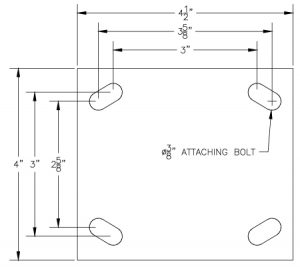
From small to large, light to heavy, top plates provide the most secure and convenient method of mounting, making them the most common means of mounting a caster. While a top plate is just a piece of metal with four bolt holes, it is critical to get the correct hole pattern when replacing a caster with a top plate.
A typical bolt hole pattern is 2-⅝” x 3-⅝” slotted to 3” x 3”. This means that the holes on the outside most part of the plate are 2-5/8″ x 3-5/8″ then slotted to the inner part at 3″ x 3″, as seen in the image to the right. Some top plates do not come with slotted holes, others have holes slotted in other directions. Generally speaking, a caster series, with the exception of furniture casters, is defined by its top plate size.
Top plate casters are available in furniture, institutional, industrial and kingpinless types.
While it may be easy to determine the type of mount your caster uses, it may be more difficult to figure out the exact size needed. Let our caster experts help to ensure you get the right caster the first time, and every time.
From small to large, light to heavy, top plates provide the most secure and convenient method of mounting, making them the most common means of mounting a caster. While a top plate is just a piece of metal with four bolt holes, it is critical to get the correct hole pattern when replacing a caster with a top plate.
A typical bolt hole pattern is 2-⅝” x 3-⅝” slotted to 3” x 3”. This means that the holes on the outside most part of the plate are 2-5/8″ x 3-5/8″ then slotted to the inner part at 3″ x 3″, as seen in the image to the right. Some top plates do not come with slotted holes, others have holes slotted in other directions. Generally speaking, a caster series, with the exception of furniture casters, is defined by its top plate size.
Top plate casters are available in furniture, institutional, industrial and kingpinless types.
While it may be easy to determine the type of mount your caster uses, it may be more difficult to figure out the exact size needed. Let our caster experts help to ensure you get the right caster the first time, and every time.




